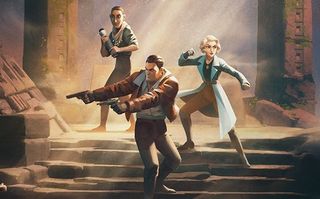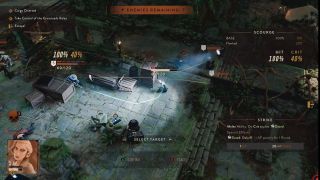This tactics game is going all-in on pulp classics, mashing up Indiana Jones, The Mummy, and XCOM to make something surprisingly original
In The Lamplighters League, you lead a secret group of scoundrels fighting against an occult army in the 1930s.

Finally, a strategy game with immolated, magical mummies for me to throw grenades at.
The Lamplighters League (Steam page) is an XCOM-alike from the the creators of Shadowrun: Hong Kong and BattleTech, so it's no surprise that it makes a good first impression. But as I sat down to be one of the first in the world to see it last week, I wasn't expecting how much Lamplighters' pulp-inspired, Indiana Jones/The Mummy/League of Extraordinary Gentlemen mid-war setting feels welcome in a somewhat crowded genre.
You're not running a paramilitary organization like XCOM: the League is made up of 10 named, recruited characters who interact in voiced conversations, can be captured if you fail a mission, and are mechanically bespoke. Célestine is a femme-fatale flapper who's sold her soul in order to gain occult powers, like a hypnosis feat that turns enemies into temp teammates. Fedir is an ex-mob enforcer Russian who gets stronger as he takes damage. Engineer Judith Harlow uses a shield and gadgets to draw aggro and build up a separate health bar of protective armor. "Every character fights really differently" and has their own skill tree, says Chris Rogers, game director on Lamplighters.
Thieves, criminals, assassins, smugglers—they're not the best of the best, but "the best of the worst," as studio head and co-founder Mitch Gitelman describes them. From my hour spent seeing them, I think that the 10 characters will avoid the trap of trying to recreate Indiana Jones or another iconic figure; they're more like a 1932 Suicide Squad, minus the superpowers. More characters are seemingly on the way post-release.
"The Lamplighters League is made by a team who loves turn-based tactics games and wants to build on the way players connect to their squads," says Gitelman. "By focusing on unique characters and the pulps' sense of adventure, we hope to weave personality and narrative into our characters' in-game abilities and the way they play, and welcome folks to the new world we've created."

Cloak and dagger
One of the other major distinctions between Lamplighters and its genre peers is that it isn't fully turn-based: a real-time infiltration phase precedes missions. Controlling your three-character squad as a little troupe, you freely wander the same map you eventually perform combat on, sort of like a top-down action game.
Individual or small groups of enemies patrol the map or stand guard, each emanating an awareness ring that represents Lamplighters' light stealth system. "Each of our characters has a limited number of real-time takedowns that they can use to sort of soften up the enemy," says Rogers. Choosing which troublesome enemies to pick off is part of the opening phase, as is the work of scouting and positioning your trio. Sometimes there'll be environmental actions you can take, like smashing through a crumbling wall to open up a flank. You're setting the table for the turn-based fight to follow, a twist I like.
The biggest gaming news, reviews and hardware deals
Keep up to date with the most important stories and the best deals, as picked by the PC Gamer team.
Outside of these tactical missions, Lamplighters plays out like XCOM's globe-spanning whack-a-mole, with a world map, divided into regions, fought over by three houses of The Banished Court, the occult organization you're battling over the course of the campaign. Heist missions contain major story beats and can reward you with artifacts that characters can equip, while character recruitment, rescue missions (which appear after you lose someone in a mission), and other tasks populate the globe. Each of those Banished Court factions is making independent progress, achieving permanent upgrades for themselves if you let them do evil unimpeded. And a little bit like XCOM's Avatar project, if a faction reaches 100% progress on its scheme it'll trigger a last-stand style mission to see if your heroes can prevent a game over.
Thieves, criminals, assassins, smugglers—they're not the best of the best, but "the best of the worst."
I walked away from my short demo of Lamplighters optimistic about its place in the genre. Its soft-but-serious art design is effective, with the UI reflecting art deco details of the time and characters looking stylized but not cartoonish. The disappointment of Empire of Sin by Romero Games (also published by Paradox) created a little skepticism about how portable XCOM was as a template, but Lamplighters is clearly only using XCOMbat as a starting point, unafraid to introduce new ideas (allies and enemies also accumulate stress), putting welcome spin on what we've been playing since 2012.


Evan's a hardcore FPS enthusiast who joined PC Gamer in 2008. After an era spent publishing reviews, news, and cover features, he now oversees editorial operations for PC Gamer worldwide, including setting policy, training, and editing stories written by the wider team. His most-played FPSes are CS:GO, Team Fortress 2, Team Fortress Classic, Rainbow Six Siege, and Arma 2. His first multiplayer FPS was Quake 2, played on serial LAN in his uncle's basement, the ideal conditions for instilling a lifelong fondness for fragging. Evan also leads production of the PC Gaming Show, the annual E3 showcase event dedicated to PC gaming.

I desperately hope Dragon Age: The Veilguard, Baldur's Gate 3 and Disco Elysium inspire more RPG devs to reject the traditional drip, drip, drip of DLC and expansions

FF14 is finally fixing the fact my carefully-constructed portraits keep reverting to a goddamn driver's licence photo whenever I change my goddamn gear
Most Popular


